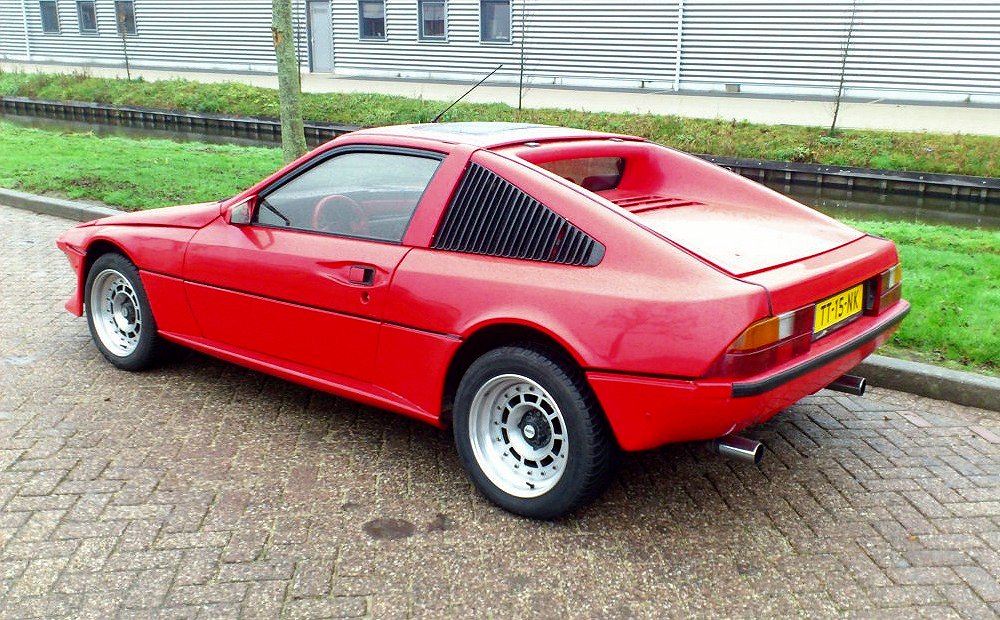Description
The Talbot-Matra Murena 2.2 Turbo was an extremely rare, near-mythical high-performance evolution of the standard Murena 2.2 — a prototype developed in tiny numbers and never officially offered for sale. Conceived at a time when forced induction was becoming the fastest route to extracting serious power from relatively small engines, the Turbo project represented the most extreme attempt to transform Matra’s mid-engined coupé into a true high-performance GT. Although it never reached production, the 2.2 Turbo stands today as one of the most fascinating chapters in the Murena story, hinting at what the model could have become had Matra remained committed to sports-car development.
The Turbo prototype was based on the existing 2.2-litre Chrysler-Simca inline-four used in the regular Murena 2.2, but heavily modified. The engine received a specially designed turbocharger installation, revised pistons, an intercooling solution adapted to the Murena’s compact engine bay and extensive changes to fuelling and ignition. The goal was to extract significantly more power while retaining the smoothness and broad torque characteristics of the naturally aspirated 2.2. Contemporary estimates place output at roughly 180 horsepower — around fifty per cent more than the stock engine and considerably above even the Danielson-tuned 142-horsepower Murena S.
This dramatic increase in power transformed the Murena’s character. With its low kerb weight and clean aerodynamics, the car gained the acceleration and high-speed ability to rival much more expensive GTs of the early 1980s. Performance figures were never formally published, but surviving test notes and accounts suggest a top speed above 220 km/h (137 mph) and acceleration that placed it well ahead of all production Murena variants. Yet for all its strength, the turbocharged engine was intended to remain tractable and usable, with a strong and flexible torque curve rather than an abrupt, high-boost delivery.
To cope with the greater performance, the Turbo prototype’s chassis was strengthened and retuned. The fully independent suspension — double wishbones at the front and trailing arms at the rear — received uprated springs and dampers, along with slight changes to geometry to improve stability under boost. The mid-engine layout and wide track continued to give the car excellent balance, and testers reported that the stronger chassis response made the car feel more settled at higher speeds. Brakes were upgraded with ventilated front discs to match the new performance ceiling.
Visually, the Turbo model remained very close to the standard 2.2, preserving the Murena’s clean aerodynamic form, long tapered nose and sharply angled fastback tail. The fibreglass-reinforced polyester bodywork stayed unchanged in shape, which helped maintain the car’s excellent drag coefficient. Subtle distinctions included additional cooling provisions at the rear, discreet badging and wheels more befitting the performance focus. For the most part, however, the Turbo project prioritised engineering substance over dramatic styling changes.
Inside, the car retained the Murena’s unique three-across seating arrangement — still one of the most unusual and practical interiors ever offered in a mid-engined sports car. The cabin remained driver-focused, with clear instrumentation and the familiar wide, low dash. Turbo-specific instrumentation was added to monitor boost and temperatures, but the general layout remained unchanged. Comfort and practicality were still part of the package, emphasising the car’s intended role as a fast, refined GT rather than a stripped-out track special.
The Murena 2.2 Turbo never went into production for several reasons. The looming end of Chrysler Europe and the subsequent transition to the Talbot brand created strategic uncertainty. The mid-1980s brought increasing financial pressures, and Matra’s resources were being redirected toward the development of the Renault Espace — a project that would ultimately become far more commercially important than any sports car. The Turbo programme was therefore quietly shelved. Only a very small number of prototypes — believed to be one complete, fully running development car and a handful of experimental engines — were completed.
Today, the Talbot-Matra Murena 2.2 Turbo is one of the rarest and most captivating Matra projects. It represents the logical extreme of the Murena’s engineering potential: a lightweight, aerodynamically clean, well-balanced mid-engined coupé given the power it always deserved. The surviving prototype, preserved within Matra’s heritage collection, stands as a fascinating reminder of the company’s ability to innovate and of the unrealised future of French high-performance sports cars.
It remains a symbol of “what might have been” — the apex of Matra’s sports-car engineering, achieved just before the company stepped away from the segment altogether.

